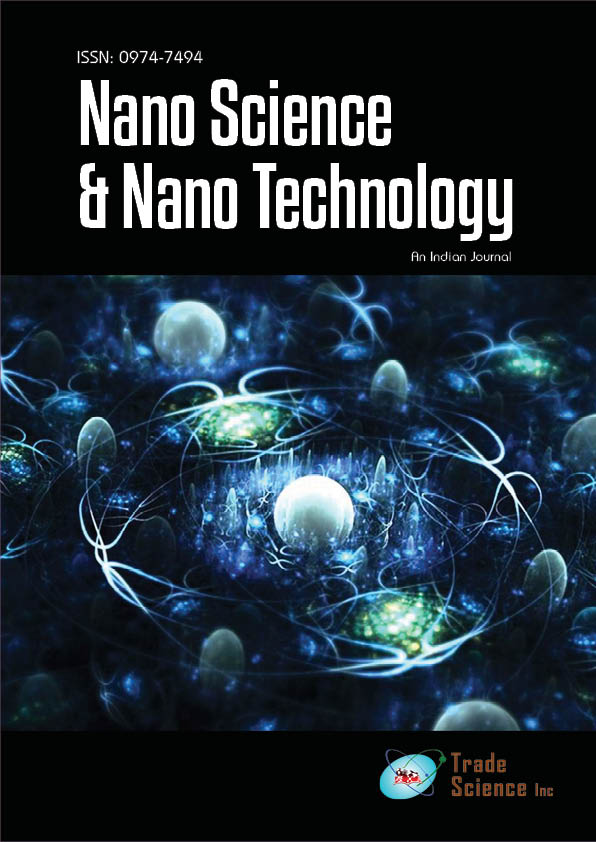Current opinion
, Volume: 16( 4) DOI: 10.37532/ 0974-7494.2022.16(4).155Advancements in Nanomedicine and Molecular Imaging
Citation:Hicks A. Advancements in Nanomedicine and Molecular Imaging. Nano Tech Nano Sci Ind J. 2022; 16(4):155
Abstract
Medical imaging techniques have developed through three stages since the development of X-rays: initially structural imaging, more recently functional imaging, and currently molecular imaging. Molecular imaging (MI) is a medical technology that examines biological processes in living creatures quantitatively and qualitatively at the cellular and molecular levels.
Introduction
Medical imaging techniques have developed through three stages since the development of X-rays: initially structural imaging, more recently functional imaging, and currently molecular imaging.
Molecular Imaging (MI) is a medical technology that examines biological processes in living creatures quantitatively and qualitatively at the cellular and molecular levels.
MI makes use of certain molecules (i.e., molecular probes or contrasts) to spot nuances in cell biochemistry that define healthy or pathological processes. In order to create Nano sized structures, nanomedicine is a brand-new area of multidisciplinary research that combines the biochemical knowledge of pathologic mechanisms with the laws of physics, chemistry, and genetics. Recent collaborations between these fields have produced a vast array of nanoparticle-based contrast agents, each of which has the potential to advance disease detection, diagnosis, and treatment. The limitations and prospects for early illness diagnosis, patient stratification, and tailored gene and drug delivery methods are being revealed by new Nano systems in the physical, chemical, and biological realms.
In order to accurately diagnose diseases at an early stage, molecular imaging allows us to non-invasively visualise cellular functions and biological processes in living subjects. A suitable contrast agent with great sensitivity is needed for effective molecular imaging. Numerous nanoparticles have been created as contrast agents for various medical imaging modalities up to this point. Nanoparticles provide a number of benefits over conventional probes, including easy surface modification, tunable physical properties, and lengthy circulation times. It is essential to provide a suitable contrast agent with high sensitivity for molecular imaging. Significant advancements in nanotechnology have made it possible to precisely regulate the size, makeup, and other characteristics of nanoparticles.
Optics-focused nanoparticles
An effective and somewhat inexpensive method for in vitro and in vivo imaging of cells and cellular processes is optical imaging. Quantum dots (QDs) are the fluorescent labelling technique that has attracted the most attention. The Bohr radius of the exciton is less than the physical size of quantum dots, or QDs. This property is typically linked to semiconductors smaller than 100 nm. In order to probe hitherto unresolved concerns about the diagnosis and treatment of diseases, biomedical researchers can use the spectrum of colours provided by QDs to mark crucial biochemical cellular traits. These tunable properties of QDs are dependent on their nanometer-sized structures. Optical imaging is quick, cheap, and sensitive when compared to MRI and CT imaging. Optical imaging can deliver real-time, high-resolution images while whole-body imaging techniques like MRI and PET have restricted temporal and spatial resolution. Since only optical microscopy is capable of capturing subcellular events, optical imaging has been extensively researched to comprehend how different nanomaterials behave in living things. For instance, optical imaging makes it possible to see how different types of cells, such as immune cells, interact with nanoparticles.
Conclusion
Early-stage diagnosis, prognosis, and even treatments of numerous diseases are easily achievable using the various imaging modalities. The toolkit for molecular imaging has been greatly influenced by nanotechnology, which adds extra features like comprehensive molecular data. For use in molecular imaging, a variety of functional nanomaterials have been researched. High resolution and sensitivity are made possible by molecular imaging thanks to the new features of nanoparticles. In comparison to contrast agents made of tiny molecules, nanoparticles have good bio distribution, lengthy circulation times, and a variety of additional features. Multifunctional nanomaterials can also be used as theranostic or multimodal imaging agents.
It is acknowledged that the development of tailored nanomedicine is a particularly alluring approach to improving early medical care and achieving superior individual outcomes.
Nevertheless, compared to materials based on small molecules, the clinical translation of nanoparticles has been slower. For nanoparticles to be used in medicine, a number of major issues such as toxicity, biocompatibility, targeted effectiveness, and longterm stability must be resolved. Above all, it is exceedingly desired to do lengthy toxicological tests on nanomaterials using big animal models. Non-human primates are likely to play a crucial role in determining whether nanoparticles are suitable for use in biomedical applications because they share a great deal of similarities with humans in terms of shape, physiological function, and genetic makeup. Prior to their application in the clinic, unanticipated adverse effects on non-human primates following the administration of nanoparticles should be explored. To gather the needed information, it is also crucial to select the best nanomaterials and imaging modalities.

